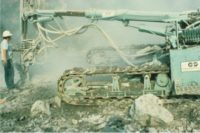OSHA is extending the comment period for its proposal to revise provisions that may be confusing, outdated or unnecessary in the agency's recordkeeping, general industry, maritime and construction standards. Originally scheduled to expire Dec. 5, the comment period will be extended to Jan. 4, 2017, to allow parties more time to review the rule and collect necessary information and data for comments. Individuals may submit comments electronically at www.regulations.gov. Comments also may be submitted by facsimile or mail.
OSHA's Standards Improvement Project, Proposed Revisions
Reporting job-related hearing loss
OSHA recordkeeping regulations require employers to record and report occupational injuries and illnesses. The proposed revision codifies current enforcement policy and clarifies that a determination whether an employee's hearing loss is "work-related" must be made using specific, clear criteria, which are also set out in OSHA regulations.
Control of Hazardous Energy (Lockout/Tagout)
The proposed revision clarifies employers' duties under the lockout/tagout standard. The existing general industry standard requires protections against the "unexpected energization" of machinery during servicing. The proposed revision to remove the term "unexpected" reflects OSHA's original intent and eliminates confusion regarding applicability of the standard.
Chest X-Ray (CXR) Requirements
The proposed revision removes the requirement for periodic CXR in the standards for inorganic arsenic, coke oven emissions, and acrylonitrile to make OSHA's requirement consistent with current medical practices and reduce employer burden and paperwork.
X-Ray Storage
The proposed revision permits storage of x-rays in digital formats. OSHA adopted the existing requirement for storage of x-ray film before the existence of digital x-ray and storage technology.
Lung-function testing
The proposed revisions update the lung-function testing (spirometry) requirements for the cotton dust standard to make them consistent with current medical practices and technology.
Feral Cats
Existing requirements in the sanitation standard for Shipyard Employment specify that employers must maintain workplaces in a manner that prevents vermin infestation. OSHA recognizes that feral cats pose a minor, if any, threat, and tend to avoid human contact, and OSHA proposes to remove the term "feral cats" from the definition of vermin in the standard.
911 Emergency Services at Worksites
Existing construction regulations require employers to conspicuously post telephone numbers for ambulances, etc. at worksites located in areas where 911 emergency dispatch services are not available. The proposed revision updates this requirement to reflect the predominance of the use of cellular telephones at construction sites and the widespread adoption of 911 emergency dispatch services. The proposed revision requires the posting of location information at worksites in areas that do not have Enhanced 911 (which automatically supplies the caller's location information to the dispatcher).
Permissible Exposure Limits (PELs)
The proposed revisions to the construction PELs requirements are corrections and clarifications to make this standard consistent with other OSHA PELs standards.
Process Safety Management of Highly Hazardous Chemicals
To avoid unnecessary duplication, OSHA proposes to replace the entire thirty-one pages of regulatory text for the Process Safety Management of Highly Hazardous Chemicals (PSM) Standard for construction with a cross reference to the identical general industry standard.
Personal Protective Equipment
Ensuring that personal protective equipment (PPE) properly fits each employee is essential to employees' protection. The proposed revision to require employers to select PPE that properly fits each employee clarifies the construction PPE requirements and makes them consistent with general industry requirements.
Lanyard/lifeline Break Strength
The proposed revision standardizes break-strength requirements for lanyards and lifelines throughout the construction and general industry standards.
Manual on Uniform Traffic Control Devices (MUTCD)
The proposed revisions update and clarify the provisions related to traffic signs and devices, flaggers, and barricades to align with current DOT requirements. This removes the burden on construction employers, who have sought this change, to follow multiple sets of regulations for OSHA, DOT, and state and local governments.
Load Limit Postings
The proposed revision exempts single family dwellings from a requirement to post maximum safe-load limits for floors in buildings under construction, reducing a burden for residential builders. The existing OSHA standard requires posting in residential dwellings where safe-load limits are rarely, if ever, an issue, thus eliminating a paperwork burden for construction employers.
Excavation Hazards
The proposed revision clarifies employers' duties in the excavation standard. The proposed revision clarifies that a hazard is presumed to exist when loose rock or soil and excavated material or equipment is beside a trench.
MSHA Underground Construction – Diesel Engines
Existing regulatory language requires that mobile diesel-powered equipment used underground comply with outdated Mine Safety Health Administration's (MSHA) provisions. The proposed revision updates the regulatory language to cross-reference to the revised MSHA provisions.
Underground Construction
The proposed revision replaces outdated decompression tables used to protect employees working in pressurized underground construction sites. The proposal allows employers to use the modern French decompression tables.
Rollover Protective Structures
The proposed revision replaces the outdated construction standard with references to the appropriate consensus standards.
Regulation of coke oven emissions in construction
The proposed revision removes the regulation of coke oven emissions provisions from the construction standards. Any work during operation of coke ovens is general industry work, and the standard does not fit construction work.
Collection of Social Security Numbers
The proposed revision comprehensively removes from general industry, construction, and maritime standards all requirements to include an employee's social security number on exposure monitoring, medical surveillance, and other records in order to protect employee privacy and prevent identity fraud.


